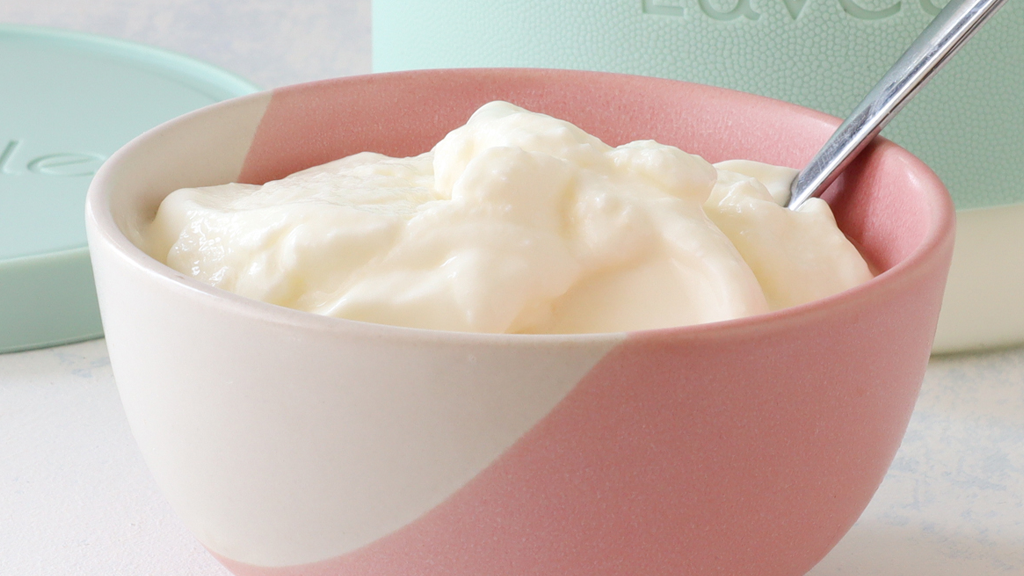Your Cart is Empty

How to Use Yogurt as a Starter Culture for Homemade Yogurt
Barb Hodgens
Barb Hodgens loves to cook with alternative, healthy whole food ingredients, with a focus on gut health. Barb has overcome her own gut health issues through healthy eating. Share your ideas, comments and photos at the end of this post :)

The most economical way to make yogurt!
When it comes to making homemade yogurt, there are two simple ways to kickstart the fermentation process: using a freeze-dried starter culture or a small portion of yogurt. In this post, we’re diving into the second method, using yogurt as your starter. We’ll share the benefits, important considerations, and a few handy tips to help you get the best results.
The idea of using yogurt to make more yogurt hinges on live cultures. Yogurt naturally contains beneficial bacteria, mainly Streptococcus thermophilus and Lactobacillus bulgaricus, which are essential for fermentation. When you add a spoonful of yogurt with active cultures to fresh milk, these microorganisms begin working to turn it into yogurt all over again.

Choosing the Right Yogurt
Not all yogurts are created equal, especially when it comes to using them as a starter. The quality of your yogurt will directly affect the outcome of your new batch, so here’s what to look for:
Store-Bought Yogurt
Choose a plain, natural, or Greek yogurt that is unflavoured, unsweetened, and free from additives or thickeners. The label should mention “live and active cultures” or list bacterial strains like Streptococcus thermophilus and Lactobacillus bulgaricus.
Homemade Yogurt
If you already make yogurt at home, you’re in luck! Homemade yogurt is naturally additive free and typically more potent with good bacteria than store-bought, thanks to longer fermentation times. One of the joys of homemade yogurt is being able to reuse it to culture future batches, saving you money and giving you full control over your ingredients.

Important Considerations
While it’s possible to use yogurt as a starter multiple times, it’s not recommended to reuse it indefinitely. Over time, the bacteria in the yogurt can become less active and less diverse, which can affect the quality and consistency of future yogurt. Additionally, the risk of contamination or mutation can increase with each successive batch. Monitor how many times the yogurt has been reseeded and keep an eye out for changes in flavour and texture.
Pro Tip: Store Starter yogurt Separately
To keep your starter yogurt fresh, and avoid contamination, always scoop out a portion from a newly made batch and store it in a small airtight glass jar in the fridge. Use it within 3 weeks.
Heat Matters: Don’t Kill the Cultures
Yogurt bacteria are heat sensitive. Always ensure the milk has cooled to below 108°F (42°C) before stirring in the starter yogurt. Temperatures above 43°C can destroy the beneficial bacteria, resulting in failed fermentation.
Want a Thicker Yogurt?
If you prefer your yogurt extra thick and creamy, like Greek-style, consider adding dry milk powder to increase the milk solids. You can add this either before or after heating the milk. As a guide, use 1/3 cup of dry milk powder per litre of milk. For even extra added firmness, heat and hold the milk at 180°F (82°C) for 10–20 minutes.

PREPARATION
Before you begin it is important to sterilise the Luvele yogurt making glass jar and any utensils you use, in boiling hot water. Do this by boiling a kettle and carefully pouring the hot water in the jar and over the equipment. The danger of not sterilising is that other bacteria may overpower your culture and affect the quality of your ferment.

How to Use Yogurt as a Starter Culture for Homemade Yogurt
Luvele
Rated 5.0 stars by 1 users
When you add a spoonful of yogurt with active cultures to fresh milk, these microorganisms begin working to turn it into yogurt all over again.
Ingredients
- Cow’s milk
- ½ cup / 125ml / 125g of plain yogurt
- 1/3 cup / 40g Dry milk powder (per litre of milk)
Directions
- Measure the appropriate quantity of milk to fill your Luvele yogurt maker and pour into a large, clean saucepan.
- Heat the milk to 82° C (180° F). Stir the milk with a wire whisk as it heats so that the milk powder doesn’t settle and burn at the bottom of the saucepan.
- (Optional) Hold the heat for 10-20 minutes.
- Cover the milk and let cool to below 42° C (107° F). It is fine if the milk cools down well below 42° or even goes cold, it just mustn't be too hot. Temperatures above 43° C will kill the starter culture. The perfect temperature range for making yogurt is between 36° C (97° F) and 42° C (107° F). As the milk cools, a layer of skin may form on the yogurt. There is no harm leaving it in. It does not produce lumpy yoghurt.
- (Optional step) Measure 1/3 cup of dry milk powder per litre of milk and add it to the milk. It may form clumps as you whisk it in. Don’t worry. Once incubated the dry milk solids dissolve and incorporate.
- Add the yogurt andthoroughly whisk it into the milk.
- Put the lid on the glass jar and place into your yogurt maker. Pour water slowly into the base. The water must not be filled over the ‘tall line’ indicated on the inside wall of the maker. Place the cover lid on top. Use the digital control panel to set the temperature to 38° C (100° F), the time somewhere between 12 & 24-hours and then press ‘confirm’ to begin incubation.
- After the fermentation is complete.Switch the yogurt maker off. Condensation will have collected under the cover lid. Take care removing it and allow the water to drip into the water bath, instead of your bench!
- Remove the yogurt jar from the water bath. Straight from the maker the yogurt will be runny and warm. Place the jar in the fridge for at least 6 hours to chill and set. Be gentle with the warm yogurt and don’t stir it or else it won’t set in a perfect white mass. Depending on the milk you used, your yogurt may have a thin layer of cream on top.
- Before diving into your fresh, chilled, tub of homemade yogurt, scoop out half a cup to use as a starter for your next batch. Store it in a glass airtight container in the fridge for up to 3 weeks.
Recipe Video


PIN THIS RECIPE


How to Use Yogurt as a Starter Culture for Homemade Yogurt

The most economical way to make yogurt!
When it comes to making homemade yogurt, there are two simple ways to kickstart the fermentation process: using a freeze-dried starter culture or a small portion of yogurt. In this post, we’re diving into the second method, using yogurt as your starter. We’ll share the benefits, important considerations, and a few handy tips to help you get the best results.
The idea of using yogurt to make more yogurt hinges on live cultures. Yogurt naturally contains beneficial bacteria, mainly Streptococcus thermophilus and Lactobacillus bulgaricus, which are essential for fermentation. When you add a spoonful of yogurt with active cultures to fresh milk, these microorganisms begin working to turn it into yogurt all over again.

Choosing the Right Yogurt
Not all yogurts are created equal, especially when it comes to using them as a starter. The quality of your yogurt will directly affect the outcome of your new batch, so here’s what to look for:
Store-Bought Yogurt
Choose a plain, natural, or Greek yogurt that is unflavoured, unsweetened, and free from additives or thickeners. The label should mention “live and active cultures” or list bacterial strains like Streptococcus thermophilus and Lactobacillus bulgaricus.
Homemade Yogurt
If you already make yogurt at home, you’re in luck! Homemade yogurt is naturally additive free and typically more potent with good bacteria than store-bought, thanks to longer fermentation times. One of the joys of homemade yogurt is being able to reuse it to culture future batches, saving you money and giving you full control over your ingredients.

Important Considerations
While it’s possible to use yogurt as a starter multiple times, it’s not recommended to reuse it indefinitely. Over time, the bacteria in the yogurt can become less active and less diverse, which can affect the quality and consistency of future yogurt. Additionally, the risk of contamination or mutation can increase with each successive batch. Monitor how many times the yogurt has been reseeded and keep an eye out for changes in flavour and texture.
Pro Tip: Store Starter yogurt Separately
To keep your starter yogurt fresh, and avoid contamination, always scoop out a portion from a newly made batch and store it in a small airtight glass jar in the fridge. Use it within 3 weeks.
Heat Matters: Don’t Kill the Cultures
Yogurt bacteria are heat sensitive. Always ensure the milk has cooled to below 108°F (42°C) before stirring in the starter yogurt. Temperatures above 43°C can destroy the beneficial bacteria, resulting in failed fermentation.
Want a Thicker Yogurt?
If you prefer your yogurt extra thick and creamy, like Greek-style, consider adding dry milk powder to increase the milk solids. You can add this either before or after heating the milk. As a guide, use 1/3 cup of dry milk powder per litre of milk. For even extra added firmness, heat and hold the milk at 180°F (82°C) for 10–20 minutes.

PREPARATION
Before you begin it is important to sterilise the Luvele yogurt making glass jar and any utensils you use, in boiling hot water. Do this by boiling a kettle and carefully pouring the hot water in the jar and over the equipment. The danger of not sterilising is that other bacteria may overpower your culture and affect the quality of your ferment.
:recipekit:


PIN THIS RECIPE


SUBSCRIBE
Sign up to get weekly healthy recipes & information on new product releases.
Item is added to cart


